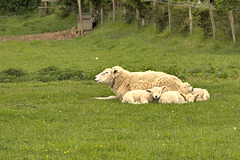Doug Shepherd's photos
Rowan (Mountain ash) blossom bursting out
Public footpath (HFF Everyone) (1 x note)
| |
|
|
|
HFF 27/5/2022
*In England and Wales a public footpath is a path on which the public have a legally protected right to travel on foot. In some areas public footpaths form a dense network of short paths. It is probable that most footpaths in the countryside are hundreds of years old. The majority of footpaths are shown on Ordnance Survey 1:25,000 and 1:50,000 maps.
In the picture above the public footpath starts on the other side of the gate, passing over land forming part of a farm.
Bidens ferulifolia
Nature's Spring display (4 x PiPs)
| |
|
|
|
Spring display 001
| |
|
|
|
Spring display 002
| |
|
|
|
Spring display 004
| |
|
|
|
Highlanders (2 x PiPs)
| |
|
|
|
Highland cattle (Scottish Gaelic: Bò Ghàidhealach; Scots: Heilan coo) are a Scottish cattle breed. They have long horns and long wavy coats that are coloured black, brindle, red, yellow, white, silver (looks white but with a black nose) or dun, and they are raised primarily for their meat. They originated in the Highlands and Western Isles of Scotland and were first mentioned in the 6th century AD. The first herd book described two distinct types of Highland cattle but, due to crossbreeding between the two, only one type now exists and is registered. They have since been exported worldwide.
See you!(Just)
| |
|
|
|
Highland cattle (Scottish Gaelic: Bò Ghàidhealach; Scots: Heilan coo) are a Scottish cattle breed. They have long horns and long wavy coats that are coloured black, brindle, red, yellow, white, silver (looks white but with a black nose) or dun, and they are raised primarily for their meat. They originated in the Highlands and Western Isles of Scotland and were first mentioned in the 6th century AD. The first herd book described two distinct types of Highland cattle but, due to crossbreeding between the two, only one type now exists and is registered. They have since been exported worldwide.
Bad hair day
| |
|
|
|
Highland cattle (Scottish Gaelic: Bò Ghàidhealach; Scots: Heilan coo) are a Scottish cattle breed. They have long horns and long wavy coats that are coloured black, brindle, red, yellow, white, silver (looks white but with a black nose) or dun, and they are raised primarily for their meat. They originated in the Highlands and Western Isles of Scotland and were first mentioned in the 6th century AD. The first herd book described two distinct types of Highland cattle but, due to crossbreeding between the two, only one type now exists and is registered. They have since been exported worldwide.
Light and shade of the Spring canopy
| |
|
|
|
Ewe and trio
Common or Scotch Broom ((Cytisus scoparius)1 x PiP…
| |
|
|
|
Common in Great Britain and Ireland, Broom was considered a sign of plenty when it bore many flowers. However a traditional rhyme from Sussex warns: "Sweep the house with blossomed broom in May/sweep the head of the household away." Broom was also used in a decorated bundle of broom at weddings in place of rosemary when that was scarce, and its strong smell was said to be able to tame wild horses and dogs. In Italy, the shrub was burnt to stop witches.
Broom plants typically grow to 1–3 m (3.3–9.8 ft) tall, rarely to 4 m (13 ft), with main stems up to 5 cm (2.0 in) thick, rarely 10 cm (3.9 in). Stems are ridged and green. The shrubs have green shoots with small deciduous trifoliate leaves 5–15 mm long, and in spring and summer are covered in profuse golden yellow flowers 20–30 mm from top to bottom and 15–20 mm wide.
Broom contains scoparin, which is a diuretic. The plant also is used as a cathartic and as a cardiac stimulant, which is credited to the presence of sparteine. A decoction (the boiling of plant material) or infusion of broom can be used to treat dropsy due to its diuretic action. An ointment can be made from the flowers to treat gout.
Do not try any of the above at home!
Nature takes back (HFF Everyone)
| |
|
|
|
HFF 20/5/2022
Recently closed Forestry England Nursery plantation fields are already showing signs of nature taking back that that belongs to nature.
Glowing!
| |
|
|
|
Lesser Stitchwart (Stellaria graminea)
| |
|
|
|
Lesser Stitchwort will often be found growing alongside hedgerows, and on the edges of woodland, but its preferred habitat is dry meadows and grassy slopes.
It has loose clusters of white flowers which are 15-18mm across. The flowers have five petals which are divided length-ways more than halfway (giving the appearance of having ten petals) with sepals behind that are the same length.
A Lesser Stitchwort flower only lasts for 3 days but the plant continuously flowers throughout the summer months.
The word Stitchwort dates back to the 1200's and as its name suggests this plant was an old remedy used to cure the common stitch!


















